
Commercial Road
Page updated 20 June 2009
 The development of the
woollen industry along Exeter's leats saw the banks of the River Exe
become the engine of growth for the city. A map
of 1805 by Roper shows rackfields spreading across Shilhay, with a coal
quay at the eastern end where is now found the Warehouse clubs. The
map shows Edmund Street in the west, but no sign of Commercial Road.
The development of the
woollen industry along Exeter's leats saw the banks of the River Exe
become the engine of growth for the city. A map
of 1805 by Roper shows rackfields spreading across Shilhay, with a coal
quay at the eastern end where is now found the Warehouse clubs. The
map shows Edmund Street in the west, but no sign of Commercial Road.
By 1835 a map by Schmollinger shows Great Shilhay still covered by
rackfields. The area known as Little Shilhay between Coneylake, the
channel that made Great Shilhay an island, and the Lower Leat was
gradually developed with a road, initially named, City Road running
from
Edmund Street across to the quay. The first map to show City Road as
Commercial Road was published in 1850 - it also indicates the first
buildings spreading across Great Shilhay as it became Gabriel's Wharf
timber yard.
Commercial Road was lined with warehouses, foundries, tanners, many
general businesses and tenements. There were two pubs to keep the
locals happy, one the well known Bishop Blaize, the oldest outside the
city walls, and the forgotten Foresters Arms, on a site that became
part of the Pleasure Ground. Bodley and Taylor occupied Northam's
foundry, the largest industrial building in the road, taking up a
large site between Great Shilhay and Commercial Road at the western
end. Tremlett's Tannery, Exeter's largest, also in Commercial Road,
would have left the area with a particularly unpleasant smell.
The Flying Post refers to various nuisances in the road through the 19th-century. Mr Tuckett's piggery and ammoniacal plant were thought to be injurious to health in 1849, and it was reported that he intended to remove it to a farm out of the city. A memorial of complaint was submitted to the council in March 1871 because of the "great nuisance caused by the boiling of putrid bones in the Shilhay." The leat that ran next to part of Commercial Road was a danger, especially to children who often fell in. It was planned in March 1833 to cover over the leat to prevent accidents, but maps and later events indicate that it was not done.
The Clubs
In December 1877, plans and specification were submitted by Mr C E Ware for a new bonded cellar for Messrs Jones and Son, and a tender of £2100 was accepted from Mr Foaden of Ashburton for the work. The lease in September 1878 was signed with Jones and Son and the common seal of the council affixed. This building now houses Tiffany's and Mambos. Kennaway and Co built the red brick bonded store, now housing Havana, in the 1890's.
The old Commercial Inn at the other end of Commercial Road was demolished, and in June 1880, Norman and Pring proposed to extend their existing cellars under the site of the inn into its old cellars. The plan was referred to the committee as the new cellar had to be able to take the weight of the road.
The presence of a grocer, butcher and shopkeeper in Commercial Raod indicates a local community living among the industry. The trade directories don't hint at the large number of families living in small, overcrowded tenements off Commercial Road. Victoria Cottages are shown on an 1891 map,as cramped terraced houses with small yards, sandwiched between warehouses and industrial buildings. There are many other terraces on the road or off little alleys on each side. There was even a small pleasure garden on the south side of Commercial Road. Two bridges provided access to Great Shilhay from Commercial Road.
World War One Dead - Commercial Road
Pioneer, E Burns, Royal
Engineers. 4 January 1919. Age 53. Milford Commercial Road
Corporal,
Henry John Bewes Skinner, King's Own Yorkshire Light Infantry. 9 April
1917. Age 23. Commercial Rd
Private, William George Webster,
Devonshire Regiment. 1 December 1918. Age 25. Commercial Rd
The end of the road
When Exeter was rebuilding in the 1960's, it was
decided to build two new bridges across the Exe and a main route from
Magdalen Street to link with the bridges. This work cleared much of the
West Quarter. Shilhay was also cleared of its industrial heritage,
while Marsh Barton expanded, as the main commercial area of the city.
Apart from Cricklepit, the Bishop Blaize and the warehouses at the
eastern end of Commercial Road, most of the old buildings were
demolished. The City Brewery disappeared, under the old Exe Bridge
grassed
area. British Telecom built offices north of Commercial Road, while the
area south of the road was developed in 1979 into an award winning
housing scheme designed by Marshman, Warren and Taylor. The press said'City's Colditz wins design
prize'. In the event, the result was later referred to as 'well
designed and successfully relates to the existing area'.
So from rackfields and mills, to foundries, tanneries and timber
yards and on to housing and offices, Commercial Road and Shilhay have
gone
through many changes. A walk along the river bank around Shilhay does
not hint at its important part in the development of Exeter, and
thankfully, it is now free of the poverty and deprivation that was once
a part of Commercial Road.
Trade directory entries for Commercial Road in 1897.
Commercial Road
Bridge street to The Quay.
North side
Norman & Pring, brewers (City brewery)
..................here is Edmund st
Attwood Thomas, cooper
8 Sanford Henry, boot maker
13 Chudley Mrs. Fanny,shopkeeper
19 Tremiett Brothers tanners
Bayley Frederick, carrier
Serconibe George, seed mer
21 & 61 Ridge William, furniture remover
Huxham & Browns,tanners engineers
Bishop Blaize inn, Henry Silnion
French W. & Co. millers (water)
Gabriel Thomas & Sons, saw mills
Burrow Wm. corn dealer (Lower mills)
27 Milford Joseph. wheelwrght
Devonshire Baryta Chemical Co. (Matthew J. Duneford, manager)
31 Tapper Wm. Hy. wheel wght
34 HorwillWm. Hy. hay dealer
36 Bastin & Son, machinists
..................here is The Quay
South side
Jones W. L. & Son, bonded stores
James (Edward), Rowe & Co. lead merchants
Kennaway & Co. Limited, bonded stores
44 Sercombe John, haulier
44 (back of) Brockington Ernest, cab proprietor
46 Bayley Mrs. Elizabeth, furniture remover
Tapper & Farley, mineral water manufacturers
Bodley Bros. & Co. engnrs. &c
52 Harris Samuel, grocer
..................here is Odger's row
55 Baulker Wm. chmny. swpr
Foresters' Arms P.H. Wm. Clements
..................here are Ware's bdgs
..................here is The Shilhay
57 Rowden John Edwin, butcher
61 & 21 Ridge William, furniture remover
62 Jarman John, carrier
63 King John, millwright
64 Kerswill John, builder
Silmon Henry, sand merchant
Taylor & Bodley, engineers &c.(Northam's foundry)
73 Taylor & Bodley, engineers & public weighbridge
73 Chenneour Frederick, tinplate worker
Great Western Railway Receiving Office, John Balsom, manager
Davy William, general dlr
Goad W. & Son, cabinet makers &c
Sources: Various trade directories and maps and other articles on this site.
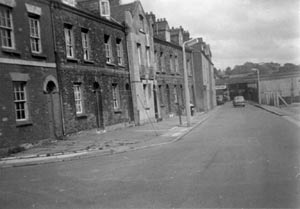 Commercial
Road housing in 1962. These houses backed onto the lower leat, just
below Horsepool Bridge. Courtesy of David
Cornforth
Commercial
Road housing in 1962. These houses backed onto the lower leat, just
below Horsepool Bridge. Courtesy of David
Cornforth
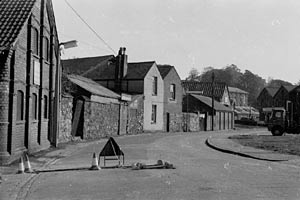 The north side of Commercial Road,
circa 1967.
The north side of Commercial Road,
circa 1967. 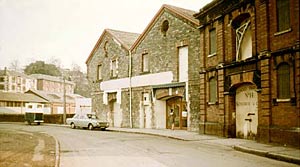 The Warehouse and Quay Clubs in the 1960's.
The Warehouse and Quay Clubs in the 1960's.
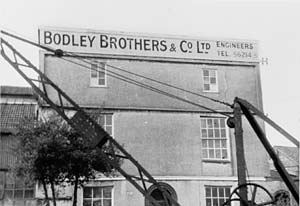 The Bodley Brothers building.
The Bodley Brothers building.
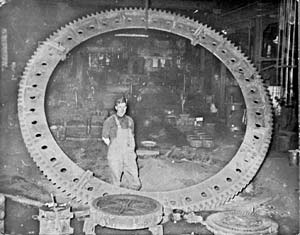 A
Bodley gear in the works.
A
Bodley gear in the works.
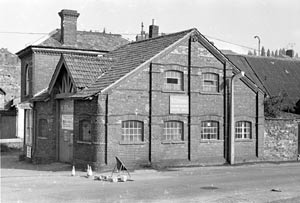 This building still survives as an
upmarket gallery. Above five photos courtesy of Alan H
Mazonowicz.
This building still survives as an
upmarket gallery. Above five photos courtesy of Alan H
Mazonowicz.
│ Top of Page │